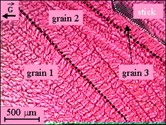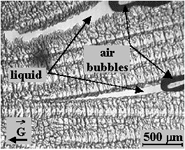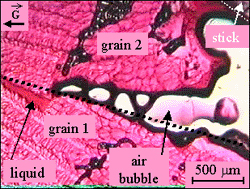
An Article from the January 2002 JOM-e: A Web-Only Supplement to JOM
 |
TMS
ONLINE | TMS
PUBLICATIONS | SITE
MAP An Article from the January 2002 JOM-e: A Web-Only Supplement to JOM |
|
|
|
|
The
authors of this article are with the
Laboratoire de Metallurgie Physique at Ecole Polytechnique Federale de
Lausanne.
|
Exploring traditional, innovative, and revolutionary issues in the minerals,
metals, and materials fields.
|
| OUR LATEST ISSUE |
|
|
OTHER ARTICLES IN THE SERIES |
|---|
|
|
|
Hot tears are cracks that initiate during solidification (i.e. at non-zero
solid fraction). They represent a major defect commonly encountered during the
casting of large freezing range alloys and can lead to catastrophic cracking
of the cast parts. In Figure 1a, a cracked
rolling sheet ingot of very large dimensions is shown. In this example, two
hot tears that were initiated during the start-up phase degenerated in two long
cracks all along the ingot. In extrusion billets, hot tears are located in the
center of the cast part, as shown in Figure
1b. This phenomenon leads to a loss in productivity as high as ten percent
for some very sensitive alloys. The study of hot tear formation has gained a
new interest during the last few years, in particular with the derivation of
predictive criteria1,3,5,6
that can be implemented in finite element method models of casting.
Hot tears originate from a lack of liquid feeding of the mushy zone,1
especially at the end of solidification, and, more precisely, as highlighted
by Campbell, when grains start to impinge and finally touch one another, but
are still surrounded by a continuous liquid film.3
Most hot tearing criteria neglect the importance of thermomechanical aspects
and simply consider the solidification interval of the alloy:3
the larger the freezing range, the more susceptible is the alloy to hot tearing.
Clyne and Davies4 defined
a criterion in which the time interval spent by the mushy zone in a vulnerable
stage appears. As an alternative, Feurer5
focused on the liquid present between the grains and argued that a hot tear
will nucleate as a pore if the liquid is no longer able to fill the intergranular
openings. Rappaz et al.1
extended Feurer's approach in order to take into account the feeding associated
with both solidification shrinkage and tensile deformation of the solidifying
material. Recently, Farup and Mo6
formulated a two-phase model of a deforming, solidifying mushy zone where both
interdendritic liquid flow and thermally-induced deformation of the solid phase
were taken into account.
Although the investigations on as-cracked surfaces flourish, in situ observations
of hot tear formation are rare. Nevertheless, transparent organic alloys offer
an interesting alternative to observe the formation of hot cracks. Succinonitrile
with acetone (SCN-acetone alloy) was selected by Farup et al.7
to induce hot tearing by mechanical pulling of the mushy zone during directional
solidification. The same device has been used in the present investigation with
two improvements: the use of a second solute element, a dye, which helps in
distinguishing the liquid, the solid, and the voids, and the control of the
pulling speed by an electrical motor. The main purpose of the present work is
to visualize in situ hot tear formation during solidification, and, in particular,
to study the nucleation of hot tears and the coalescence of grains.
|
|
|
|||
|
|
|
|
||
| Figure 1. (a-left) Hot tears in an aluminium slab that led to a complete cracking of the ingot; (b-right) Typical hot tear in extrusion billets.2(Click on the figures to enlarge them). | Figure 2. The schematics of the experimental device used to observe in-situ the formation of hot tears in succinonitrile-acetone alloys (Click on the figure to enlarge it). | |||
|
|
|
|||
The set-up used to induce hot tears in SCN-acetone is essentially the same as that used by Farup et al.7 As depicted in Figure 2, the succinonitrile-acetone alloy contained in a thin glass cell is solidified in a constant temperature gradient (Bridgman-type experiment) by moving it away from a heat source with an electrical motor at a constant velocity (typically 10 mm/s). In Farup's experiments, a "puller" was used to manually pull apart the growing dendrites in the transverse direction, while the current experiments achieved the same results, albeit with better control of the applied strain rate, using a supplementary electrical motor. A small quantity of Fuchsin was added to the transparent alloy (typically 0.05 wt.%) to enhance the contrast between the different phases of the system (liquid, solid, air). Temperature was measured every second by placing a type-K thermocouple, 50 mm in diameter, in the cell. This measurement was coupled with video recording of the growing dendrites in order to deduce the temperature at which dendrites coalesce or bridge.
The observation of hot tears is performed on time by a color video camera mounted on an optical microscope positioned on top of the set-up. As already reported in Reference 7, hot tears always appear between two grains; the grain boundary being the last part of the system to solidify. Moreover, two situations can be distinguished from these observations. First, when the stick is pulled at too high liquid fractions, liquid can feed the opening because of the high permeability of the mush. Therefore, the crack is healed by solute-enriched liquid and no defect results from this event, as shown in Figure 3, except maybe some enhanced segregation.
|
|
|
|
 |
||
|
Figure 3. A healed hot crack (Click on the figure to enlarge it). |
|
|
|
|
|
Animation 1 shows how, by using a stick to induce
a tensile opening in the organic alloy, deformation concentrates at the grain
boundary. The dotted lines indicate the position of grain boundaries. In this
case, the opening takes place between grains 2 and 3 (i.e., closest to the stick).
Moreover, the solid fraction at this point of solidification is still low enough
to allow liquid metal to feed the opening owing to the relatively high permeability
of the mush. This leads to the formation of a healed crack avoiding any formation
of hot tears.
It can be observed in Animation 1 that the tensile
deformation induced by the stick is compensated by some liquid flow. The direction
of this flow is revealed by the movement of some equiaxed grains that have nucleated
in the solute-enriched liquid and which are moving to the right. During the
opening, some dendritic arms grow in the liquid spacing between the two grains,
as shown in Figure 4.
|
|
|
|
 |
||
|
Figure 4. An opening fed by some solute-enriched liquid (Click on the figure to enlarge it). |
Figure 5. Two hot cracks growing in intergranular liquid film regions (Click on the figure to enlarge it). |
|
|
|
|
The second situation observed in hot tears is that when the stick is pulled
at a sufficiently high solid fraction (i.e., deep in the mushy zone where the
permeability is low), some liquid cannot feed the opening from the tip of the
dendrites and an intergranular crack appears, as shown in Figure
5 and Animation 2. Moreover, it can be seen
from the deformation of the dendrites during pulling that they are particularly
ductile at this temperature. Please note that two cracks are growing in parallel
in this figure. The air bubble with the larger tip radius (top) is slightly
ahead of the sharper one (bottom) as a result of the associated curvature depression
(Laplace term).
The pressure in the intergranular liquid associated with both the solidification
shrinkage and the tensile deformation increases owing to the inability of the
liquid to feed the opening and reaches the cavitation pressure at which an air
bubble appears. One can clearly see in Animation 2
air bubbles propagating into the opening thus creating a hot crack.
|
|
|
|
 |
||
|
|
|
|
|
|
|
Animation 3 shows more precisely the flow of air
bubbles in the opening created by the pulling of the stick in the SCN-acetone
alloy. It explains clearly how the entrapped porosity contributes to the formation
of a hot tear. Moreover, it highlights the unstable equilibrium due to the associated
curvature depression between the opening of the crack, the tip radius of the
bubble and the movement of the bubble.
Figure 6a shows a typical cooling
curve obtained with the thermocouple inserted in the cell. The cooling rate
is constant during the experiment (-0.03 K/s) until heating is switched off
at lower temperature to speed up solidification (slope changes at 1,100 s).
By associating temperature measurements with video observations of the solidifying
transparent alloy, the liquidus temperature, Tliq, has been measured (see Figure
6b). In the same manner, the coalescence temperature of dendrites across
a grain boundary (intergranular coalescence temperature), Tcg, and within a
grain (intragranular coalescence temperature), Tcd, have been evaluated, as
shown in Figures 7a and 7b
and Figures 8a and 8b,
respectively. Coalescence, or bridging of dendrite arms, is established when
the liquid film between two adjacent dendrites or two grains is no more continuous
(see Figure 7b and Figure
8b). Intergranular and intragranular coalescence does not occur simultaneously:
Figures 7a and 7b
were taken about 400 s after Figures 8a
and 8b. These coalescence temperatures
are highly dependent on the experimental conditions and on the disorientation
of the grains. For this reason, the values of Tcd
and Tcg reported in Figure
6a are mean values estimated from several measurements. Tcd
is around 43.8°C whereas Tcg is much lower,
27.6°C. Indeed, for dendrites belonging to the same grain, no grain boundary
energy has to be overcome to establish bridges.
Using the back-diffusion model of Clyne and Kurz8
and the thermophysical properties of Glicksman et al.,9,10
Grasso et al.11 estimated
the solid fraction at intergranular and intragranular coalescence: fs(Tcg)
= 0.99 and fs(Tcd)
= 0.95.
Coalescence of dendrite arms has also been observed by catching the very moment when liquid films are no longer continuous. Intragranular coalescence is found to occur at a solid fraction around 95%, whereas intergranular coalescence takes place much deeper in the mushy zone at a higher solid fraction, around 99%. Further work should be carried out in order to determine more carefully when bridging of dendrites occur as a function of the grain boundary energy. Indeed, coalescence is a key parameter for the understanding of the mechanical property of the mush and of the hot tearing phenomenon. The theoretical foundation of coalescence within a grain and at grain boundary is also being established.12
This research was carried out as part of the Fifth Framework Competitive
and Sustainable Growth program project GRD1-1999-10921 VIRCAST (Contract No.
G5RD-CT-2000-00153). It included the partners: Alusuisse
Technology & Management Ltd., Switzerland, Calcom
SA, Switzerland, Elkem Aluminum
ANS, Norway, Ecole Polytechnique
Federale de Lausanne, Switzerland, Hoogovens Corporate Services, The Netherlands,
Hydro Aluminum AS, Norway,
Institute National Polytechnique
de Grenoble, France, Institute
National Polytechnique de Lorraine, France, Norwegian
University of Science and Technology, Norway, Pechiney
S.A., France, VAW aluminum
AG, Germany, and IFE, Norway
and SINTEF, Norway, as major subcontractors.
Funding by the European Community and by the Office
Federal de l'education et de la Science (Bern) for the Swiss partners is
gratefully acknowledged.
1. M. Rappaz,
J.-M. Drezet, and M. Gremaud, Met.
and Mater. Trans. A, 30A (February 1999), p. 449.
2. I. Farup, "Thermally
Induced Deformations and Hot Tearing During Direct Chill Casting of Aluminum"
(Ph.D. thesis, University of Oslo,
Norway, 2000).
3. J. Campbell, Castings
(Oxford, U.K.: Butterman-Heinemann Ltd., 1991).
4. T.W. Clyne and G.J. Davies,
J. Brit. Foundry, 74 (1981), p. 65.
5. U. Feurer, Giessereiforschung,
Heft 2 (Neuhausen am Rheinfall, Schweiz, 1976), p. 75.
6. I. Farup and A. Mo, Met.
and Mater. Trans. A, 31A (May 2000), p. 1461.
7. I. Farup, J.-M. Drezet, and
M. Rappaz,
Acta Materialia 49 (2001), pp. 1261-1269.
8. T.W. Clyne and W. Kurz, Metall.
Trans. A, 12A (1981), p. 965.
9. M.E. Glicksman, R.J. Scjaeffer,
and J.D. Ayers, Metall.
Trans., 7A (1976), p. 1747.
10. M.E. Glicksman, P.W. Voorhees,
and R. Setzko, "The Triple-Point Equilibria of Succinonitrile: Its Assessment
as a Temperature Standard", TEMPERATURE, Its measurement and Control
in Science and Industry, Vol. 5, Part I (Amer. Inst. of Physics, 1982),
p. 321.
11. P.-D. Grasso, J.-M. Drezet,
I. Farup, and M. Rappaz (Paper presented at EUROMAT Conference, Rimini, 2001).
12. M. Rappaz, A. Jacot, and
W. Boettinger, to be submitted to Met.
Mater. Trans.
For more information, contact P.-D. Grasso, Ecole Polytechnique Federale de Lausanne, Laboratoire de Metallurgie Physique, MX-G CH-1015, Lausanne, Switzerland; pierre-daniel.grasso@epfl.ch; http://dmxwww.epfl.ch/lmph/simul/index.htm
Direct questions about this or any other JOM page to jom@tms.org.
| If you would like to comment on the January 2002 issue of JOM, simply complete the JOM on-line critique form | |||||
|---|---|---|---|---|---|
| Search | TMS Document Center | Subscriptions | Other Hypertext Articles | JOM | TMS OnLine |